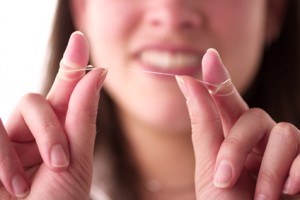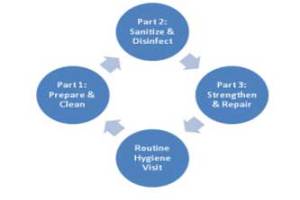If you are a follower of our blog or if you’ve had your teeth cleaned any time within the past ten years you’ve been  told that flossing is incredibly important for dental and periodontal health. A common question about flossing that I receive is: Are there alternatives to traditional floss? And, can I use a Waterpik instead of floss?
told that flossing is incredibly important for dental and periodontal health. A common question about flossing that I receive is: Are there alternatives to traditional floss? And, can I use a Waterpik instead of floss?
- Waterpik falls under the category of a water flosser. This device uses a stream of air and water to clear debris from between the teeth and around the gingival area. Another popular brand of water flosser is the Sonicare AirFloss.
- Some studies show that there is little difference between effectiveness of water flossers vs. traditional floss
- My professional opinion is that mechanical flossing when done correctly is more effective than using a water flosser. My first recommendation to the majority of patients is to use traditional floss.
- However, effectiveness is contingent on flossing correctly. Many people do not floss correctly either because they were never taught how to, or lack the manual dexterity to do so. Flossing incorrectly although still helps to keep the teeth clean, can cause you to be less effective while flossing. And, may cause minor irritation to the gums.
- Some patients who have had an injury or have a disability such as arthritis simply may not capable of flossing. Patients who can not floss at all or are causing more damage than good with traditional floss will show better results with a water flosser.
- In general, if you are curious if a water flosser is appropriate for your home care we recommend asking your dentist or hygienist if a water flosser is a good option for you. They will evaluate you as well as teach you the best method to clean your teeth and gums.

 After years in the dental office, I can tell you that it’s very rare to find a patient who goes more than 3 years without a cavity.
Knowing that home care is one of the most important aspects of maintaining a healthy mouth, my partners and I set out on creating a home care regimen that’s relatively easy and will provide the results we are hoping to achieve, a decrease in cavities and improvement in overall oral health.
The final breakthrough of my home care routine recommendations came while reading Dr. Ellie Phillips book Kiss Your Dentist Goodbye. During our daily care routine, we are mainly focusing on removing and repairing the damage we’ve already done during the day. Removing plaque mostly and strengthening enamel. However, Dr. Ellie’s book brings up a great point, we aren’t focusing on improving the overall environment of the mouth, more specifically saliva makeup.
Combining both rationales, ours which focuses on mechanics and repair, and Dr. Ellie’s which focuses on reducing the saliva’s acidity and creating a healthier environment in the mouth, we created Frangella Dental’s basic home care regimen:
After years in the dental office, I can tell you that it’s very rare to find a patient who goes more than 3 years without a cavity.
Knowing that home care is one of the most important aspects of maintaining a healthy mouth, my partners and I set out on creating a home care regimen that’s relatively easy and will provide the results we are hoping to achieve, a decrease in cavities and improvement in overall oral health.
The final breakthrough of my home care routine recommendations came while reading Dr. Ellie Phillips book Kiss Your Dentist Goodbye. During our daily care routine, we are mainly focusing on removing and repairing the damage we’ve already done during the day. Removing plaque mostly and strengthening enamel. However, Dr. Ellie’s book brings up a great point, we aren’t focusing on improving the overall environment of the mouth, more specifically saliva makeup.
Combining both rationales, ours which focuses on mechanics and repair, and Dr. Ellie’s which focuses on reducing the saliva’s acidity and creating a healthier environment in the mouth, we created Frangella Dental’s basic home care regimen: